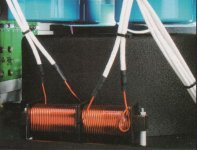If you investigated tweeker's links, the Coilcraft unit I suggested is for preciisly that same pupose. Although, most of that bis was detailing the fine points of a "Single Ended" input filter. There are also the common mode/differential inductors like I suggest, might be inexpensive and or useful(wiring the 4 pins for maximum inductance and using it as a choke). Not that anything there was wrong or inappropriate but, I work with SMPS every day (not National) and I would not be here if I wanted to read that stuff some more...
I will say, if anyone remembers the electric drill test??? That actually seems like a very good test to me. That guy probably wants some good EMI protection if he's going to be drilling to the tunes!
I will say, if anyone remembers the electric drill test??? That actually seems like a very good test to me. That guy probably wants some good EMI protection if he's going to be drilling to the tunes!
And what did the Master do? Post #22
This is what Mr Nelson uses himself in the XA 160 amps.
A ferrite core. And it looks three times as small as the air core I use myself.
They look like standard iron cores. Those will be good enough for me.
This is what Mr Nelson uses himself in the XA 160 amps.
A ferrite core. And it looks three times as small as the air core I use myself.
They look like standard iron cores. Those will be good enough for me.
An inductor with more DCR has a lower q, the resistance damps the ringing. If your inductors and capacitors start really resonating youve got trouble, as mentioned by PRR.
Heres a fairly relavent link on the Damping of Power-Converter Front-End Averaging Filters
This was helpful. Earlier I mentioned shunting to ground but your link provides the right formulas. Moreover, I had not known about the CR leg that comes ahead of the C shunt. I will study this more over the weekend. Thanks.
After dealing with this power supply stuff, my guess is that those guys at NASA probably do know more than me.
Heres a fairly relavent link on the Damping of Power-Converter Front-End Averaging Filters
This was helpful. Earlier I mentioned shunting to ground but your link provides the right formulas. Moreover, I had not known about the CR leg that comes ahead of the C shunt. I will study this more over the weekend. Thanks.
After dealing with this power supply stuff, my guess is that those guys at NASA probably do know more than me.
I recently bought a few 250va toriodal autoformers to play with.
Just for fun I hooked one up as a choke in a choke input filter.
I know it wasn't suposed to work but under a 1A load it preformed just like a "real" choke. Then I removed all the windings a real pain in the *** . The 3" core I uncovered was
wound from a continious strip of steel. Then I wound 58 turns
of #16 copper wire around it and measured ~10 mh.
Using a 18v center tap transformer, a pair of Shokey diodes, this
10mh inductor and a .25F cap I measured 7v into a 1ohm load.
When allowing for the voltage drop in the diode and sourse resistance in the inductor this matches the 9v X .88 = 7.72v
expected. The #16 wire did get slightly warm at this 7A load
them hot when loaded to 12A. but not bad for a salvaged
transformer core and ~ 8 feet of #16 copper wire. This may not
work with othe transformer cores.
Just for fun I hooked one up as a choke in a choke input filter.
I know it wasn't suposed to work but under a 1A load it preformed just like a "real" choke. Then I removed all the windings a real pain in the *** . The 3" core I uncovered was
wound from a continious strip of steel. Then I wound 58 turns
of #16 copper wire around it and measured ~10 mh.
Using a 18v center tap transformer, a pair of Shokey diodes, this
10mh inductor and a .25F cap I measured 7v into a 1ohm load.
When allowing for the voltage drop in the diode and sourse resistance in the inductor this matches the 9v X .88 = 7.72v
expected. The #16 wire did get slightly warm at this 7A load
them hot when loaded to 12A. but not bad for a salvaged
transformer core and ~ 8 feet of #16 copper wire. This may not
work with othe transformer cores.
- Status
- Not open for further replies.

